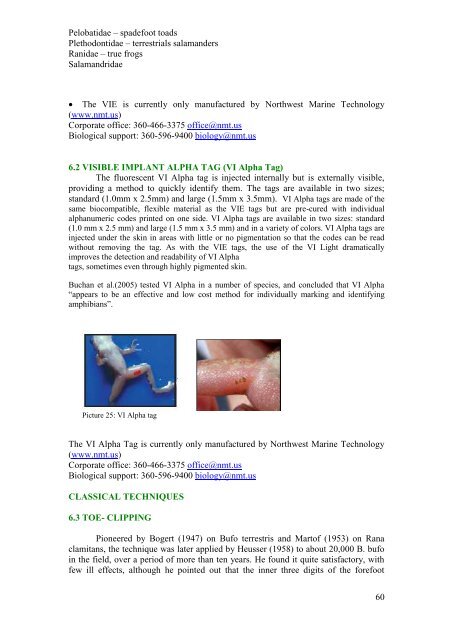standardization of records keeping in indian zoos - Central Zoo ...
standardization of records keeping in indian zoos - Central Zoo ...
standardization of records keeping in indian zoos - Central Zoo ...
Create successful ePaper yourself
Turn your PDF publications into a flip-book with our unique Google optimized e-Paper software.
Pelobatidae – spadefoot toads<br />
Plethodontidae – terrestrials salamanders<br />
Ranidae – true frogs<br />
Salamandridae<br />
The VIE is currently only manufactured by Northwest Mar<strong>in</strong>e Technology<br />
(www.nmt.us)<br />
Corporate <strong>of</strong>fice: 360-466-3375 <strong>of</strong>fice@nmt.us<br />
Biological support: 360-596-9400 biology@nmt.us<br />
6.2 VISIBLE IMPLANT ALPHA TAG (VI Alpha Tag)<br />
The fluorescent VI Alpha tag is <strong>in</strong>jected <strong>in</strong>ternally but is externally visible,<br />
provid<strong>in</strong>g a method to quickly identify them. The tags are available <strong>in</strong> two sizes;<br />
standard (1.0mm x 2.5mm) and large (1.5mm x 3.5mm). VI Alpha tags are made <strong>of</strong> the<br />
same biocompatible, flexible material as the VIE tags but are pre-cured with <strong>in</strong>dividual<br />
alphanumeric codes pr<strong>in</strong>ted on one side. VI Alpha tags are available <strong>in</strong> two sizes: standard<br />
(1.0 mm x 2.5 mm) and large (1.5 mm x 3.5 mm) and <strong>in</strong> a variety <strong>of</strong> colors. VI Alpha tags are<br />
<strong>in</strong>jected under the sk<strong>in</strong> <strong>in</strong> areas with little or no pigmentation so that the codes can be read<br />
without remov<strong>in</strong>g the tag. As with the VIE tags, the use <strong>of</strong> the VI Light dramatically<br />
improves the detection and readability <strong>of</strong> VI Alpha<br />
tags, sometimes even through highly pigmented sk<strong>in</strong>.<br />
Buchan et al.(2005) tested VI Alpha <strong>in</strong> a number <strong>of</strong> species, and concluded that VI Alpha<br />
“appears to be an effective and low cost method for <strong>in</strong>dividually mark<strong>in</strong>g and identify<strong>in</strong>g<br />
amphibians”.<br />
Picture 25: VI Alpha tag<br />
The VI Alpha Tag is currently only manufactured by Northwest Mar<strong>in</strong>e Technology<br />
(www.nmt.us)<br />
Corporate <strong>of</strong>fice: 360-466-3375 <strong>of</strong>fice@nmt.us<br />
Biological support: 360-596-9400 biology@nmt.us<br />
CLASSICAL TECHNIQUES<br />
6.3 TOE- CLIPPING<br />
Pioneered by Bogert (1947) on Bufo terrestris and Mart<strong>of</strong> (1953) on Rana<br />
clamitans, the technique was later applied by Heusser (1958) to about 20,000 B. bufo<br />
<strong>in</strong> the field, over a period <strong>of</strong> more than ten years. He found it quite satisfactory, with<br />
few ill effects, although he po<strong>in</strong>ted out that the <strong>in</strong>ner three digits <strong>of</strong> the forefoot<br />
60
















